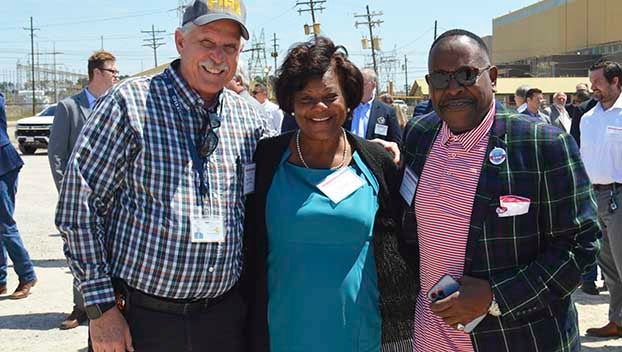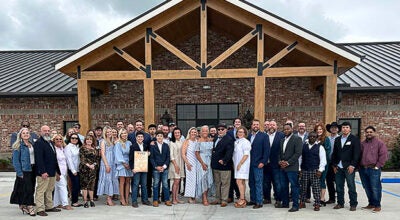Famed test pilot’s funeral Tuesday
Published 10:10 am Monday, December 3, 2018
By Ken Stickney
Maj. Gen. Harold E. “Tom” Collins’ early enlistment in the U.S. Army during World War II short-circuited his engineering studies at Lamar University in 1943. But following initial training for a field artillery unit, it steered him toward a sterling career as an Air Force test pilot during a golden age of American aviation.
Collins died Nov. 24 at 94 in San Antonio, where he and his wife, the former Dorothy Rita Joffrion, both Port Arthur natives, had moved a year after his 1975 retirement from the Air Force.
“He was an interesting guy,” said his brother-in-law, James Joffrion of Groves. “He could talk your ear off, fascinate you for hours.”
Joffrion said Collins’ lack of a college degree may have disqualified his brother-in-law from inclusion in astronaut training for the military in the mid-20th century. But it was no barrier to Collins’ litany of achievements and honors as a post-WWII test pilot.
Early achievement
He entered aviation cadet training in July 1943, earned pilot wings and was commissioned a second lieutenant at 19 a year later. He served with the 155th Photographic Reconnaissance Squad in Europe and flew 11 aerial combat missions before his 21st birthday.
His assignment to Wright Field, Ohio, in 1947 launched his career as an experimental test pilot, which continued into the mid-1960s. Much of that time was spent at Wright Field, then Wright-Patterson Air Force Base, where his assignments included operations officer of the 86th Fighter Interceptor Squadron of the Air Defense Command; assistant chief and later chief of Fighter Test Division, Aeronautical Systems Division; and later at Edwards Air Force Base in California, where he was director of flight test operations.
But his time in the cockpit marked him for lasting distinction. In September 1953 he set a world speed record for the 15-25 kilometer course, flying his F-86D Sabre at 707.889 mph. For that achievement, he was awarded the General Electric Trophy and earned national acclaim.
Later that month, he was part of a three-man crack team of experts assigned to fly a Soviet-built MiG-15 at a base in Okinawa; Maj. Gen. Albert Boyd headed the team, which included pilots Collins and Maj. Chuck Yeager. Boyd assigned Collins to fly the MiG first; Collins later recollected that Boyd said, “Yeager has had his share of firsts.”
The U.S. acquired the aircraft after a North Korean military pilot, No Kum Sok, defected and flew it to South Korea under the promise of $100,000 in reward money and asylum in a non-communist country, part of an effort dubbed “Operation Moolah.” Collins and Yeager battled bad weather to make 11 flights on the MiG from Okinawa, determining its strengths and weaknesses. While the MiG was formidable, the pilots found some grave deficiencies.
On one flight, Collins’ safety was imperiled by a lack of oxygen at a high altitude; Yeager struggled with control of the aircraft in making dive flights. Both survived.
Yeager later wrote, “Flying the MiG is the most demanding situation I have ever faced. It’s a quirky airplane that’s killed a lot of pilots.”
“He’s right,” Collins wrote years later. “But we did fly it, well past its limits, and we didn’t let it kill us.”
Project Collins
Collins’ most lasting achievement might have been his experimental work to extend the range of U.S. fighters, fighter-bombers and reconnaissance aircraft — an assignment called “Project Collins.” His Air Force biography said, “His efforts led to the first inflight refueling of aircraft under combat conditions, for which he was awarded a second oak leaf to the Air Medal for pioneering this historic achievement.”
Years later, that achievement was among many cited for his inclusion in the Museum of the Gulf Coast section for notable people. Family members had previously submitted an application for his admission to the Port Arthur museum, but Sam Monroe, president of the Port Arthur Historical Society, said that application excluded key elements of Collins’ record to enter the museum. Criteria for inclusion include links to the community, a body of work, notable contributions and public recognition.
Monroe said Collins himself later wrote to him, listing his record of accomplishments in a 17-page letter. Collins’ work on in-flight fueling and his test pilot work were plenty notable, Monroe said, and proved Collins belonged in the museum. The Maj. Gen. Harold E. Collins Trophy is awarded annually to the best Air Force refueling wing.
Collins’ story was made more notable by his climb through the military ranks without benefit of a military academy pedigree or any college degree, for that matter, Monroe said.
During his service, he studied at Air Force Test Pilot School, the Air Command and Staff College, National War College and Advanced Management Program at Harvard Graduate School of Business.
Honors include entry into the Society of Experimental Test Pilots in 1962; he was named a fellow in 1967; Distinguished Service Medal; Legion of Merit with two Oak Leaf clusters; Air Force Commendation Medal with one Oak Leaf; and Distinguished Unit Citation Emblem.
Retirement
In the latter part of his career, Collins was assigned to the U.S. Strike Command and the American Embassy in Pakistan. There, his wife “suffered two vicious and particularly aggressive attacks of debilitating hepatitis” that threatened her life and left her with permanent liver damage. His brother in law said this week that effectively ended Collins military career; his move to San Antonio, Joffrion said, was made to be closer to military hospitals.
In retirement, Collins earned the bachelor’s degree he’d missed during his career, graduating St. Mary’s University in 1978 in political science. The university said he was president of The Collins Group in San Antonio, a consulting firm. His brother in law said Collins flew small planes recreationally.
Collins and Dorothy Joffrion were high school sweethearts in the late 1930s and graduated St. James High School in Port Arthur together in 1941. He was reared in a single-family dwelling on Thomas Avenue, one of five children of Mrs. and Mrs. Lionel A. Collins. Joffrion grew up a mile away on Kings Court.
The couple had no children; her April 22, 2005 obituary recounted her efforts as a devoted military wife.
“Life for her grieving, loving Air Force retired major general husband will be empty without her,” the obituary said. “She was his life, his friend, his girl, his sweetheart, his steady, his fiancée, his bride, his lover, his soul mate, his pal, his partner, the wind beneath his wings, the love of his life and his beautiful Dottie was always there for him in good times and bad.”
Following an 11 a.m. funeral Mass at St. James Catholic Church in Port Arthur, Collins will be interred with military honors at Calvary Cemetery beside his wife’s grave. Grammier-Oberle Funeral Home is in charge of arrangements.





